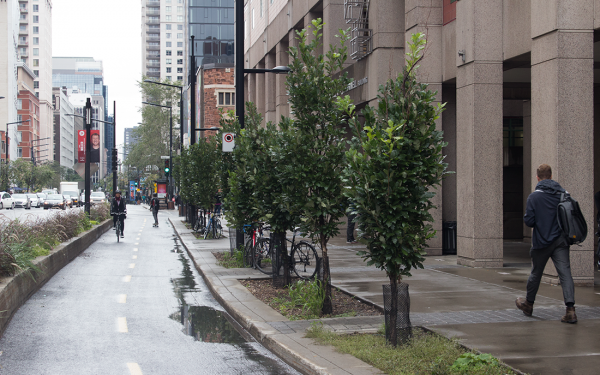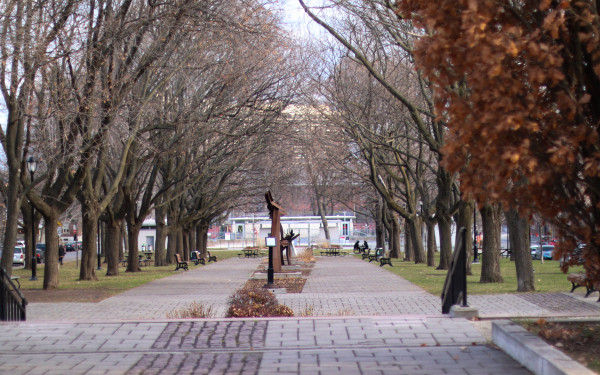Forgotten Forest
Locals Fight to Protect Falaise St. Jacques
A green chain-linked fence around the Falaise St. Jacques is torn down in some places, doing little to protect one of Montreal’s 10 ecoterritories.
Visitors of the Falaise, an escarpment below St. Jacques St., have to be willing to duck some trees, get muddy and slide down some slopes to explore the wooded area. The area appears untouched—beside the tires and debris spilling over the top of the cliff from businesses on the industrial street.
In April, Lisa Mintz, a librarian and environmentalist, noticed orange survey markers near the western end of the escarpment. When she brought it up at a citizen meeting with Turcot officials, she was assured the markings were for arrangements to protect the area’s brown snakes. By the time Mintz revisited the area in September, more than 100 trees had been felled.
“If people could see how beautiful it is down there, then I don’t know how they would possibly want to cut it down,” Mintz said.
The bulldozed area will be compensated for in the form of a 30 metre-wide green belt along the escarpment, said Sarah Bensadoun, spokesperson for Transport Quebec, which oversees the provincial highways and major roadwork. The assurances given to Mintz about the western end of the escarpment was allegedly due to miscommunication.
“They keep telling me they’re not going to cut any more trees in the Falaise, but the construction comes right up to the trees,” Lisa Mintz said. “The question is, where are they supposed to put this 30 metres?”
Mintz, a birdwatcher, says about 65 species of birds, including ravens, sparrows and warblers migrate to the cliffs of the area. The province has taken measures to preserve brown snakes, which are also found there.
Transport Quebec insists the western part of the escarpment was specifically bulldozed after mating season to reduce environmental impact.
But Mintz says the wildlife has nowhere else to go. The four-kilometre-long escarpment is some of the only green space in the area, bordered by industrial St. Jacques St., lined with car repair shops to the north, and the highway and train tracks to the south.
The cliffy-forested span is the only substantial green space near highway 20 leading up to the Turcot interchange in the Southwest borough. The highway interchange, a large elevated concrete complex dividing N.D.G. from the Southwest, was built in 1967, but a $1.5 billion contract was signed earlier this year with a private consortium to replace the current structure by 2020.
“We want to have an ecoterritory,” Réal Ménard told city hall on Oct. 26 in response to several questions about the Falaise. Ménard is a city executive member in charge of sustainable development, the environment, large parks and green spaces.
The city of Montreal’s website describes an ecoterritory as an area that isn’t protected in a strict sense—the area can contain buildings—but whose protection is deemed a “priority.” The ecoterritory designation comes from Montreal, but the escarpment is officially zoned as a park.
“We have a strong commitment to make sure that every time we have an opportunity, this administration will increase the green spaces,” said Ménard.
“We have a strong commitment to make sure that every time we have an opportunity, this administration will increase the green spaces,” said Ménard.
Talks between the city, the Southwest and N.D.G. boroughs, and Transport Quebec are ongoing, Ménard added.
“Transport Quebec has always said they were going to run a bicycle path along the bottom of the Falaise and a 30-metre corridor between the tracks and the bottom of the Falaise,” said N.D.G. city councillor Peter McQueen.McQueen has hopes for a bike path from Ville St. Pierre to St. Henri with a sound barrier between the forest, the train tracks and highway. The ultimate goal would be easy access to the Lachine Canal, a pedestrian bridge and a cross-country ski path.
“It’s possible that we’re going to end up with something nice,” McQueen said.
The timeline isn’t set yet. The Turcot project should be completed in the next five years, but McQueen hopes the bike path can be inaugurated as soon as the train tracks are relocated in a few years’ time.
“It’s been terrible getting answers,” McQueen said. At local consultations with citizens, not all Turcot representatives have answers, he said. “They’re pathetic.”
“The reason they’ve come up with the idea to fell the trees in the Falaise is no better than the reasons they’ve come up with to cut down trees in the West Island to build condo projects,” said Alex Tyrrell, a Concordia student and leader of the Green Party of Quebec.
“Most environmentalists and students would agree it’s a better decision to cut down some trees to build a bike path rather than a crane pad to build the Turcot interchange,” Tyrrell said. “But on the other hand, a bike path is still just another reason to cut down some trees and develop
the ecoterritory into something else.”
Tyrrell hopes the escarpment remains as natural as possible, and doesn’t turn into a municipal park with benches and paths.
“Certain things shouldn’t be built,” he said.

2_900_600_90.jpg)
_900_600_90.jpg)
1_900_600_90.jpg)
_600_832_s.png)


_600_375_s_c1.png)
